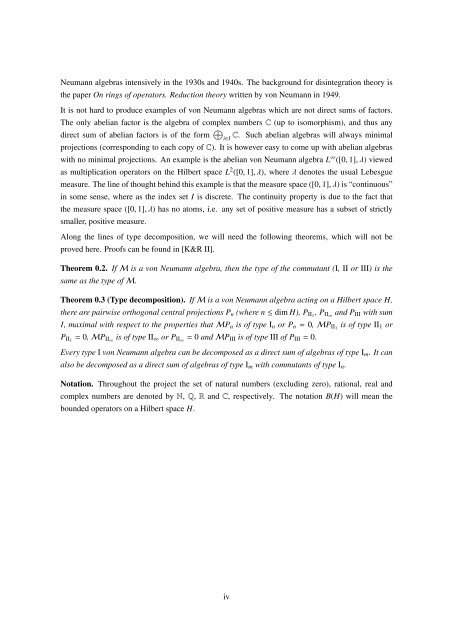Disintegration theory for von Neumann algebras
Disintegration theory for von Neumann algebras
Disintegration theory for von Neumann algebras
You also want an ePaper? Increase the reach of your titles
YUMPU automatically turns print PDFs into web optimized ePapers that Google loves.
<strong>Neumann</strong> <strong>algebras</strong> intensively in the 1930s and 1940s. The background <strong>for</strong> disintegration <strong>theory</strong> is<br />
the paper On rings of operators. Reduction <strong>theory</strong> written by <strong>von</strong> <strong>Neumann</strong> in 1949.<br />
It is not hard to produce examples of <strong>von</strong> <strong>Neumann</strong> <strong>algebras</strong> which are not direct sums of factors.<br />
The only abelian factor is the algebra of complex numbers C (up to isomorphism), and thus any<br />
direct sum of abelian factors is of the <strong>for</strong>m ⊕ i∈I<br />
C. Such abelian <strong>algebras</strong> will always minimal<br />
projections (corresponding to each copy of C). It is however easy to come up with abelian <strong>algebras</strong><br />
with no minimal projections. An example is the abelian <strong>von</strong> <strong>Neumann</strong> algebra L ∞ ([0, 1], λ) viewed<br />
as multiplication operators on the Hilbert space L 2 ([0, 1], λ), where λ denotes the usual Lebesgue<br />
measure. The line of thought behind this example is that the measure space ([0, 1], λ) is “continuous”<br />
in some sense, where as the index set I is discrete. The continuity property is due to the fact that<br />
the measure space ([0, 1], λ) has no atoms, i.e. any set of positive measure has a subset of strictly<br />
smaller, positive measure.<br />
Along the lines of type decomposition, we will need the following theorems, which will not be<br />
proved here. Proofs can be found in [K&R II].<br />
Theorem 0.2. If M is a <strong>von</strong> <strong>Neumann</strong> algebra, then the type of the commutant (I, II or III) is the<br />
same as the type of M.<br />
Theorem 0.3 (Type decomposition). If M is a <strong>von</strong> <strong>Neumann</strong> algebra acting on a Hilbert space H,<br />
there are pairwise orthogonal central projections P n (where n ≤ dim H), P II1 , P II∞ and P III with sum<br />
I, maximal with respect to the properties that MP n is of type I n or P n = 0, MP II1 is of type II 1 or<br />
P II1 = 0, MP II∞ is of type II ∞ or P II∞ = 0 and MP III is of type III of P III = 0.<br />
Every type I <strong>von</strong> <strong>Neumann</strong> algebra can be decomposed as a direct sum of <strong>algebras</strong> of type I m . It can<br />
also be decomposed as a direct sum of <strong>algebras</strong> of type I m with commutants of type I n .<br />
Notation. Throughout the project the set of natural numbers (excluding zero), rational, real and<br />
complex numbers are denoted by N, Q, R and C, respectively. The notation B(H) will mean the<br />
bounded operators on a Hilbert space H.<br />
iv

















